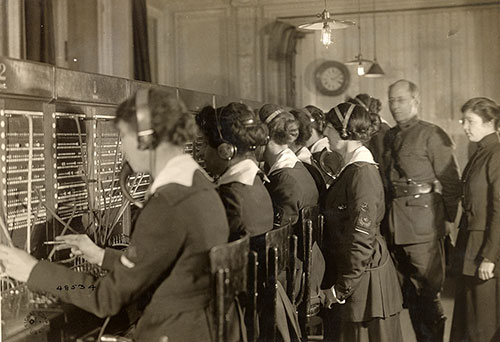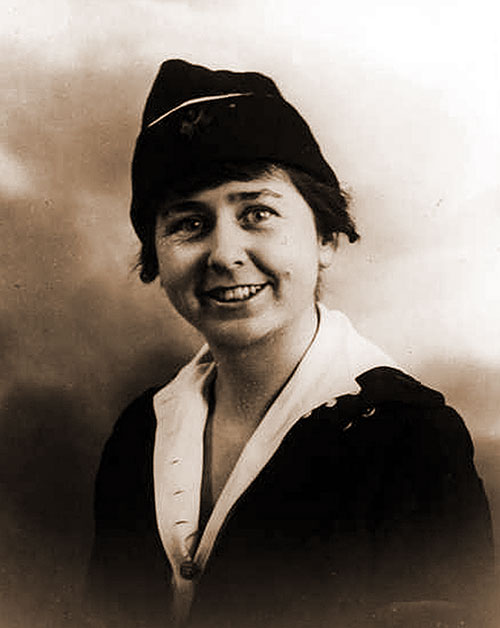Brief History of the Signal Corps Female Telephone Operators - 1996

Telephone Exchange with Women Operators, Elysees Palace Hotel. Paris, Seine, France. All Americans Sent over Here and Organized as Women's Telephone Unit, Signal Corps, USA. Personnel Include: Miss Elizabeth Shovar, Miss Maud E. Johnson, Miss Jeanne Legallet, Miss Marie B. Broderick, Miss Bertha M. Hunt, Miss Jane Lang, Miss Margaret Blegires, Miss Lillian Verkler, Miss Minnie Goldman, Miss Ida B. Lanz, Miss Albertine Arrents, Major R. P. Wheat, Signal Corps Chief Telegraph Officer. Photograph by Sgt. Brooks, Signal Corps, 10 January 1919. National Archives and Records Administration, 111-SC-48534. NARA ID # 86703177. GGA Image ID # 199ded841b
Regarding the Signal Corps' ground troops, the legislation fixed the branch's commissioned strength at 127: 1 chief signal officer, three colonels, eight lieutenant colonels, ten majors, 30 captains, and 75 first lieutenants. Congress gave the president authority to set the Corps' enlisted strength, which he subsequently fixed at 4,000, to be reached by 1 July 1920.
Moreover, the law provided for the creation of an Officers' Reserve Corps and its counterpart, the Reserve Officers Training Corps (ROTC). Of particular importance to the Signal Corps, the act created an Enlisted Reserve Corps to recruit technical specialists such as telegraphers and telephone operators.
To release men for the front lines, the Army employed approximately two hundred women telephone operators to serve overseas. These women, who retained their civilian status, became members of the Signal Corps Female Telephone Operators Unit. They are perhaps better known as the "Hello Girls."
To operate switchboards in France and England, they needed to be fluent in both French and English. Moreover, because the Army contained few French-speaking operators, these women undoubtedly made inter-Allied communications proceed much more smoothly.
In November 1917, the Signal Corps recruited women from the commercial telephone companies; to obtain enough bilingual operators, the Corps also accepted untrained volunteers who met the language requirement.
After a training period, the first detachment of women, in the charge of chief operator Grace Banker, departed from New York City early in March 1918. Soon members of the unit were operating telephone exchanges of the American Expeditionary Forces in Paris, Chaumont, and seventy-five other cities and towns in France and London, Southampton, and Winchester, England.
As always, the Signal Corps played a vital role in the operation. For example, members of the 55th Telegraph and 317th Field Signal Battalions, assigned to the V Corps, had to dig a cable trench six feet deep and one kilometer long to establish a connection with the 26th Division.
The trench ran through a hill of nearly solid rock, and the men had no explosives available. "For three days and two nights, the signalmen had one piece of bread and one cup of coffee a meal each.
There was no rest. When a man fainted from exhaustion, his comrades worked the harder, and even the officers in charge wielded picks and shovels with them."
To handle communications with the French units, six of the women telephone operators served at First Army headquarters, less than fifteen miles from the front.
Throughout the Meuse-Argonne campaign, members of the Female Telephone Operators Unit continued to work at First Army headquarters, now located near Verdun, with the initial complement of six supplemented by seven additional women.
On 13 October, a fire broke out in the barracks housing the main switchboard. The women remained on duty until they were finally forced to evacuate, but they returned to their posts within an hour.
Their devotion to duty won them a commendation from the chief signal officer of the First Army. A detachment of women also served at Second Army headquarters, but not during active operations.

Grace D. Banker, Chief Operator, US Army Signal Corps, March 1918. GGA Image ID # 199da8eedf
Grace Banker, the chief operator at First Army headquarters, received a Distinguished Service Medal for her wartime efforts.
"Black Jack's Girls," Army 32 (Dec 1982): 44-48, is about the women who served as telephone operators in Europe for the Signal Corps. They were also known as the "Hello Girls."
Though long an unofficial function, photography became an official duty of the Signal Corps during World War I and has remained an essential aspect of its work ever since. See K. Jack Bauer, comp., List of World War I Signal Corps Films, Special List 14 (Washington, D.C.: National Archives, 1957).
Rebecca Robbins Raines, Getting the Message Through: A Branch History of the U.S. Army Signal Corps, Washington DC: Center of Military History, United States Army, 1996.
